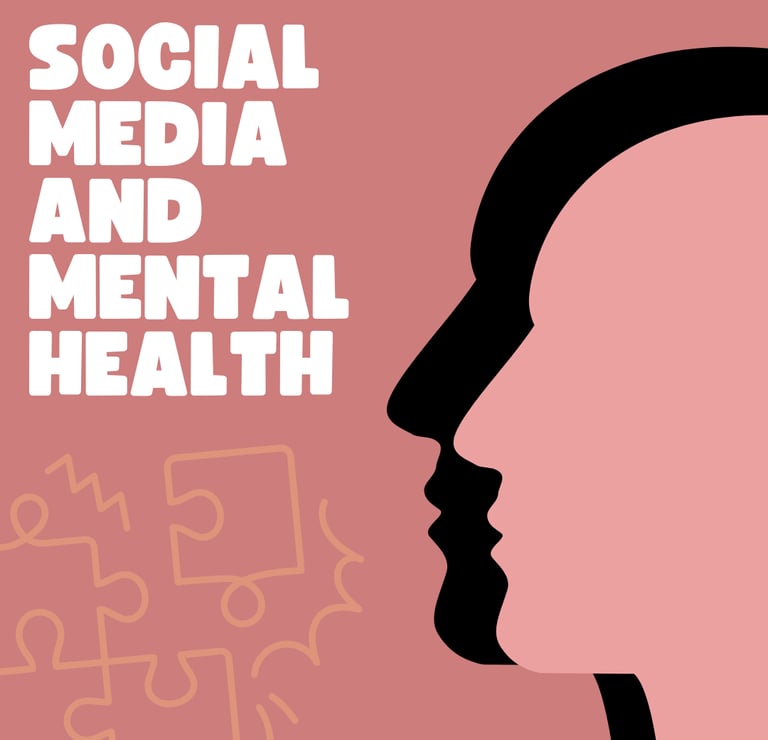The Impact of Social Media on Mental Health: A Double-Edged Sword
Discover the double-edged impact of social media on mental health. Explore its positive and negative effects with tips for mindful, healthy digital use.
SOCIAL


In today’s digital-first world, social media has become a constant companion in our daily lives. Platforms such as Instagram, Facebook, TikTok, Twitter (X), and LinkedIn allow us to connect with friends, share our experiences, and access global information instantly. While the benefits are undeniable — from building communities to discovering opportunities — there is growing concern about the impact of social media on mental health. Experts describe it as a double-edged sword, offering both positive effects and potentially harmful consequences.
This blog explores the positive and negative effects of social media on mental health, supported by research, statistics, and insights into healthier digital habits.
The Rise of Social Media in Modern Life
Before diving into its effects, it’s important to understand how deeply ingrained social media is in our daily routines. Over 4.9 billion people worldwide are active social media users as of 2025, according to Statista. The average person spends more than 2.5 hours per day scrolling, liking, sharing, or commenting on digital platforms.
The sheer scale of engagement shows why social media and mental health is now a critical issue that psychologists, educators, and health professionals continue to study.
The Positive Impact of Social Media on Mental Health
Despite the controversies, social media is not purely harmful. When used mindfully, it can have several positive effects on mental health:
1. Building Communities and Connections
Humans are social creatures, and social media creates opportunities for global connection. People with rare medical conditions, marginalized identities, or specialized interests can find supportive communities that may not exist offline. For individuals facing isolation, such as those living far from family, social media can bring a sense of belonging..
2. Raising Awareness of Mental Health Issues
Another powerful advantage is how platforms promote conversations about mental health awareness. Campaigns like #BellLetsTalk or #MentalHealthAwareness Month help normalize conversations that were once highly stigmatized. Psychologists, therapists, and advocates now use Instagram Reels, TikTok videos, and Twitter threads to provide resources, encourage therapy, and guide people struggling with anxiety or depression.
3. Access to Education and Inspiration
From mindfulness practices to guided meditations and mental wellness influencers, social media introduces valuable coping strategies. Many young adults discover motivational content, online communities for fitness, or inspirational success stories that empower them to pursue healthier lifestyles.
4. Strengthening Social Ties During Difficult Times
During global crises, such as the COVID-19 pandemic, social media became a lifeline for maintaining relationships, working remotely, and even seeking therapy online. For individuals experiencing grief, bullying, or trauma, social media offers safe spaces for storytelling and connection.
The Negative Impact of Social Media on Mental Health
For all its benefits, the negative effects of social media on mental health cannot be ignored. Experts describe it as addictive, sometimes toxic, and capable of worsening mental health struggles.
1. The Comparison Trap and Low Self-Esteem
One of the most well-documented downsides is social comparison. Platforms like Instagram are highlight reels of people’s best moments, filtered images, and luxury lifestyles. Constant exposure to curated perfection often makes users feel inadequate, leading to low self-esteem and body image issues.
2. Increased Risk of Anxiety and Depression
Studies consistently link heavy social media consumption with higher rates of anxiety and depression, especially among teens and young adults. Notifications, likes, and comments can trigger dopamine responses similar to gambling, fueling online addiction. When individuals tie their self-worth to digital approval, they’re at greater risk of emotional volatility.
3. Cyberbullying and Online Harassment
Unlike offline bullying, cyberbullying is relentless and can reach victims anytime, anywhere. Unfortunately, online harassment has severe consequences such as social withdrawal, depression, and even suicidal thoughts, particularly among young people.
4. Sleep Disruptions and Digital Overload
Blue light exposure from screens suppresses melatonin production, disrupting sleep cycles. Many people report “doom scrolling” late at night, scrolling endlessly through negative news or TikTok videos, which leads to fatigue, reduced concentration, and worsening mental health issues the next day.
5. Fear of Missing Out (FOMO)
FOMO is another psychological effect tied to social media. Seeing friends attend events, travel, or achieve milestones often creates feelings of loneliness, envy, or inadequacy. Over time, FOMO can escalate into anxiety and compulsive checking of social feeds to avoid missing updates.
Why Social Media Is a Double-Edged Sword
The reality is that social media is neither entirely good nor entirely bad. Its role in shaping mental health depends largely on how it is used. Think of it as a tool: in responsible hands, it connects people and spreads positive messages, but when overused or misused, it can negatively affect self-esteem, productivity, and overall well-being.
Tips for Healthy Social Media Use and Better Mental Health
If eliminating social media feels impossible, you can practice healthier habits to minimize its negative effects.
1. Set Time Boundaries
Using built-in “screen time trackers” on iOS and Android can help reduce daily usage. Limiting exposure to under 60–90 minutes is generally associated with healthier mental outcomes.
2. Curate a Positive Feed
Unfollow accounts that trigger stress, comparison, or insecurity. Instead, follow mental health advocates, educational communities, or uplifting content creators.
3. Prioritize Real-Life Connections
Make an effort to maintain offline interactions with loved ones. Studies show that face-to-face conversations increase oxytocin and serotonin, chemicals tied to bonding and happiness.
4. Use Social Media for Growth, Not Validation
Instead of seeking “likes” to validate your worth, use platforms as professional or creative tools. Share knowledge, showcase talents, or learn new skills instead of measuring your success through popularity metrics.
5. Practice Digital Detoxes
Consider taking breaks — a weekend without social media, or scheduling offline hobbies such as reading, hiking, or painting. These help reset your brain and improve mental resilience.
Social Media and Different Age Groups
Different demographics experience distinct impacts:
Teenagers and Young Adults are vulnerable to peer pressure, cyberbullying, and FOMO. At risk of developing a poor self-image due to heavy Instagram, TikTok, or Snapchat use.
Adults: More likely to experience information overload, productivity loss, and sleep disturbances from LinkedIn or Twitter usage.
Older Adults: May benefit from improved connection and reduced loneliness, but can also encounter misinformation and scams.
This means solutions for healthier social media use must be age-appropriate and tailored to unique challenges.
The Role of Parents, Educators, and Employers
Managing social media and mental health isn’t only about personal responsibility. Collective efforts matter.
Parents should monitor their children’s screen time, talk openly about online risks, and encourage offline activities.
Educators can integrate digital well-being lessons into classroom teachings.
Employers should promote work-life balance and minimize pressure for employees to stay “always online.”
Creating an ecosystem of healthy digital practices ensures that social media retains its benefits without becoming overwhelming.
Future of Social Media and Mental Health
Looking ahead, platforms are beginning to address these challenges. For example:
Instagram now hides like counts in some regions to reduce comparison.
TikTok and Facebook display reminders for excessive scrolling.
AI-driven content moderation detects cyberbullying and harmful content.
